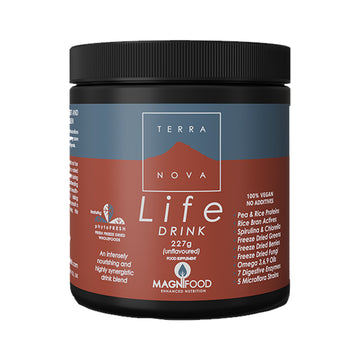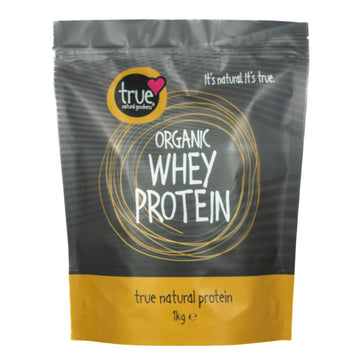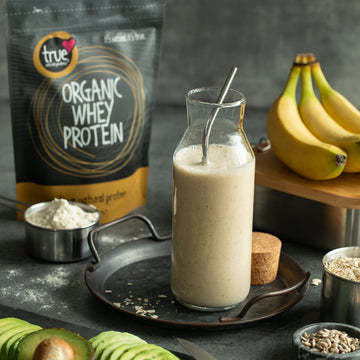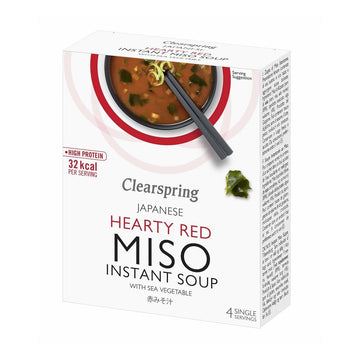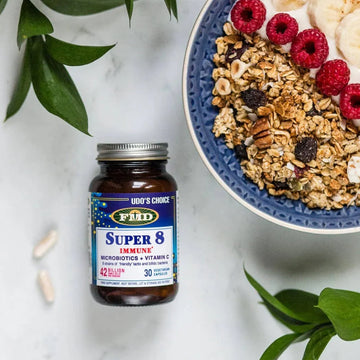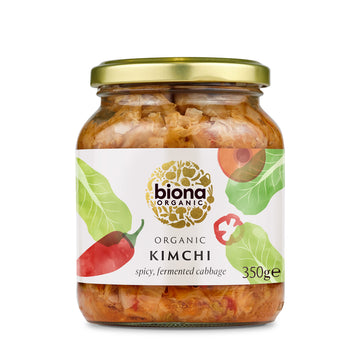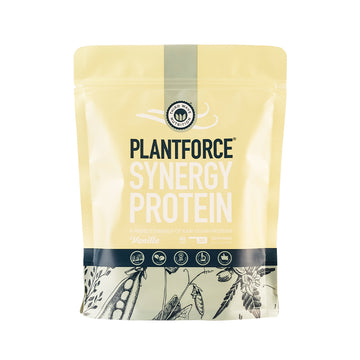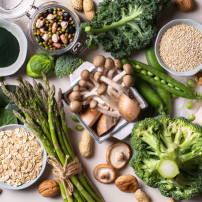Unless you’re living under a rock I think we have all heard of the newest weight loss phenomenon, the ‘miracle molecule’, GLP-1 (Glucagon-Like-Peptide-1).
Let’s take a closer look at what is makes this molecule such a talking point and what benefits can we expect from stimulating the release of GLP-1 on our metabolic function and appetite.
What is GLP-1?
Glucagon-Like-Peptide-1 is a hormone naturally produced in your body and plays a crucial role in appetite control and blood glucose regulation. In addition, it acts as a versatile helper in your digestive system by slowing digestion, signalling fullness to your brain, managing blood glucose levels, and increases feelings of satiety after meals.
Much of the research into GLP-1 has found that this hormone is hugely beneficial in supporting insulin production and utilisation. Insulin is crucial for managing your blood sugar levels, which is why researchers are excited about GLP-1 as a potential ally in the fight against type 2 diabetes and obesity.
What are GLP-1 Agonists?
GLP-1 mimicking medications like Ozempic®, Mounjaro® and Wegovy®, known as GLP-1 agonists essentially ‘trick’ your body into feeling full and better regulating blood sugar levels.
By mimicking GLP-1 function in the body, this mechanism makes these medications potentially powerful tools for weight management and metabolic health, as they tap into the body's natural processes for controlling appetite and maintaining stable blood sugar levels.
When are GLP-1 Agonists recommended?
1. Approved for Type II Diabetes since 2005
- a condition that causes the level of glucose (sugar) in the blood to become higher than normal
- Type 2 diabetes happens if your body cannot:
- make enough insulin OR use insulin properly
2. Approved for Obesity since 2017
- Obesity is commonly defined as having too much body fat.
- A BMI of 30 or higher is the usual benchmark for obesity in adults.
3. Approved for Prediabetes & Insulin Resistance since 2022
- A condition where cells in your muscles, fat, and liver don’t respond well to insulin and, over time your
- pancreas may not make enough insulin and
- your cells may become resistant to insulin
The GLP-1 Journey
There are many benefits to the use of GLP-1 agonist medications and it’s easy to see how their popularity has sky rocketed in the past decade. It is estimated that approx. 6% (15 million) of US adults are on GLP-1 medications whereas in the UK it is estimated to be around 500,000 prescriptions.
Modes of Action & Advantages
- Sensitises the cells to insulin to encourage move the glucose out of the blood and into the cell.
- Reduce Appetite and enables better portion control - Around 35% of lower calories are eaten.
- Blood glucose regulation resulting in more stable mood and energy throughout the day.
- Improve metabolism – your body’s ability to make energy from the food you eat.
- Positively impacts the microbiome and the effect of prebiotics.
Potential Side Effects
However, these mechanisms may also trigger uncomfortable side effects including:
- Nausea / Vomiting
- Acid Reflux / GI Discomfort
- Bloating / Constipation
- Malabsorption of nutrients
- Fatigue and Headaches
- and not wanting to eat at all
At Evergreen we’ve got everything you need
- Food & Lifestyle recommendations.
- Nutritional Supplements.
- Advice and Educational Information to support your GLP-1 journey.
Here are some food, supplement and lifestyle suggestions we can recommend alongside the medication to counteract the side effects of those customers on GLP-1 agonists.
1. Gastrointestinal Support
To counteract the potential gastro-intestinal discomfort of taking any of these GLP-1 agonists we suggest some of the following products:
Bone Broths
Bone broth is thought to be gentle on the digestive system and may help with nutrient absorption, which can positively impact overall health. The amino acids, like glutamine, found in bone broth may help soothe and repair the gut lining, potentially alleviating symptoms of digestive issues.
Healthline, 2025, How to Make Bone Broth, Plus Health Benefits https://www.healthline.com/nutrition/bone-broth#faq (Accessed 14th July 2025)
Prebiotics & Fibre for fullness
Prebiotics promote the growth of beneficial bacteria like Bifidobacteria and Lactobacilli, which can crowd out harmful bacteria and contribute to a more balanced gut environment. In addition, adequate fibre intake while taking a GLP-1 agonists can help alleviate constipation or any sluggish bowel motility. High fibre diets can be key to the long term success of taking GLP-1 medication.
Fermented Foods
Fermented foods are rich in probiotics, which are live microorganisms that can improve the balance of bacteria in your gut. Probiotics can aid digestion by breaking down food and making nutrients more accessible to the body. Evergreen offer a wide variety of fermented foods instore and online including Sauerkraut, Miso, Sourdough, Kimchi, Tempeh and Apple Cider Vinegar with the mother.
Brown University, 2022, The importance of prebiotics https://www.brownhealth.org/be- well/importance-prebiotics (Accessed 14th July 2025)
WebMD, 2024, Fermented Foods for Boosting Health https://www.webmd.com/diet/ss/slideshow-benefits-fermented-foods Medically Reviewed by: Zilpah Sheikh, MD (Accessed 15th July 2025)
2. Supplements
Multimineral & Multivitamin Complexes
Multivitamins and multimineral complexes can offer a range of benefits, including filling nutritional gaps, supporting overall health, boosting energy levels. They can be particularly beneficial for individuals with dietary restrictions, certain health conditions, or those who may not be getting all the necessary nutrients from their diet alone.
National Institute of Health, Office of Supplements, 2024, Multivitamin/mineral Supplements, Factsheets for Health Professionals, https://ods.od.nih.gov/factsheets/MVMS- HealthProfessional/ (Accessed 14th July 2025)
Electrolytes
GLP-1 medications, can affect hydration and electrolyte balance due to its impact on gastric emptying and potential side effects like nausea, vomiting, and diarrhoea. These side effects can lead to dehydration and electrolyte depletion.
Healthline, 2025, Does Ozempic make you thirsty?https://www.healthline.com/health/drugs/does-ozempic-make-you-thirsty (Accessed 14th July 2025)
Prioritising Protein Intake
When taking a GLP-1 agonist, it's crucial to prioritise protein intake to preserve muscle mass, manage appetite, and potentially mitigate any side effects. A high-protein diet can help you feel fuller, manage cravings, and potentially reduce muscle loss, especially since GLP-1 agonists can slow digestion and potentially lead to muscle loss as part of weight loss. Evergreen offer a wide variety of protein powder derived from a variety of sources to accommodate all dietary requirements; whey, rice, pea, soy and hemp protein powders.
Healthline, 2024, Weight Loss: Eating More Protein May Prevent Muscle Loss From GLP-1 Drugs, https://www.healthline.com/health-news/protein-muscle-loss-weight-loss- drugs#Supporting-muscle-mass-while-on-GLP-1-drugs (Accessed 16th July 2025).
Ohio State University, 2024 Taking a GLP-1? Here are foods to limit — and what to prioritize https://health.osu.edu/wellness/exercise-and-nutrition/glp1-foods-to-limit Medically Reviewed by: Samantha Snashall, RND, LD (Accessed 16th July 2025).
3. Lifestyle Recommendations
Obviously the goal and focus of anybody who chooses to take a GLP-1 agonist medication is weight loss however it’s important not to underestimate the importance of behaviour change and long-term health habits. We should be focusing on long term lifestyle changes that will help maintain weight loss long after we stop taking the medication.
- Drink up to 2 Litres of water daily.
- Regular eating windows every day:
- Breakfast 8-10am
- Lunch 12-2pm
- Dinner 6-8pm
- ‘Break your fast’ with Fats and Proteins.
- Focus on nutrient dense yet calorie poor foods.
- Move your body regularly – 3-5 times a week.
- Post prandial walks to minimise blood sugar spikes.
- Prioritise Sleep aim for a minimum of 6-8hrs a night.
Hamasaki H. Exercise and glucagon-like peptide-1: Does exercise potentiate the effect of treatment? World J Diabetes. 2018 Aug 15;9(8):138-140. doi: 10.4239/wjd.v9.i8.138. PMID: 30147850; PMCID: PMC6107470.
Do you want to know more about GLP-1? Continue the blog series with 'Harness The Power of GLP-1 Naturally'.
Full reference list
-
Bloom SR, Katsilambros N. Eating slowly increases the postprandial response of the anorexigenic gut hormones, peptide YY and glucagon-like peptide-1. J Clin Endocrinol Metab. 2010 Jan;95(1):333-7. doi: 10.1210/jc.2009-1018. Epub 2009 Oct 29. PMID: 19875483.
-
Bodnaruc AM, Prud'homme D, Blanchet R, Giroux I. Nutritional modulation of endogenous glucagon-like peptide-1 secretion: a review. Nutr Metab (Lond). 2016 Dec 9;13:92. doi: 10.1186/s12986-016-0153-3. PMID: 27990172; PMCID: PMC5148911.
-
Brown University, 2022, The importance of prebiotics https://www.brownhealth.org/be- well/importance-prebiotics (Accessed 14th July 2025)
-
Chen, I.-J., Liu, C.-Y., Chiu, J.-P., & Hsu, C.-H. (2016). Therapeutic effect of high-dose green tea extract on weight reduction: A randomized, double-blind, placebo-controlled clinical trial. Clinical Nutrition, 35(3), 592–599. https://doi.org/10.1016/j.clnu.2015.05.003
-
Guyton, J., Jeon, M., & Brooks, A. (2019). Glucagon-like peptide 1 receptor agonists in type 1 diabetes mellitus. American Journal of Health-System Pharmacy, 76(21), 1739–1748. https://doi.org/10.1093/ajhp/zxz179
-
Hamasaki H. Exercise and glucagon-like peptide-1: Does exercise potentiate the effect of treatment? World J Diabetes. 2018 Aug 15;9(8):138-140. doi: 10.4239/wjd.v9.i8.138. PMID: 30147850; PMCID: PMC6107470.
-
Healthline, 2025, Does Ozempic make you thirsty? https://www.healthline.com/health/drugs/does-ozempic-make-you-thirsty (Accessed 14th July 2025)
-
Healthline, 2025, How to Make Bone Broth, Plus Health Benefits https://www.healthline.com/nutrition/bone-broth#faq (Accessed 14th July 2025)
-
HSE, 2024, What is type 2 Diabetes? https://www2.hse.ie/conditions/type-2- diabetes/about/what-is/ (Accessed 9th July 2025)
-
Kahn, S.E., Hull, R.L. and Utzschneider, K.M. (2021) ‘Hyperinsulinemia in obesity, inflammation, and cancer’, Journal of Clinical Investigation, 131(7), e8164941.
-
Kokkinos A, le Roux CW, Alexiadou K, Tentolouris N, Vincent RP, Kyriaki D, Perrea D, Ghatei MA, Koliaki, C., & Doupis, J. (2011). Incretin-based therapy: a powerful and promising weapon in the treatment of type 2 diabetes mellitus. Diabetes Therapy, 2(2), 101–121. https://doi.org/10.1007/s13300-011-0002-3.
-
National Institute of Health, Office of Supplements, 2024, Multivitamin/mineral Supplements, Factsheets for Health Professionals, https://ods.od.nih.gov/factsheets/MVMS- HealthProfessional/ (Accessed 14th July 2025)
-
New York Times, 2025, Daily Pill May Work as Well as Ozempic for Weight Loss and Blood Sugar https://www.nytimes.com/2025/04/17/health/pill-glp-1-eli-lilly.html (Accessed 14th July 2025)
-
NIH, 2025, Insulin Resistance & Prediabetes https://www.niddk.nih.gov/health- information/diabetes/overview/what-is-diabetes/prediabetes-insulin-resistance (Accessed 9th July 2025)
-
Office for National Statistics (2024) ‘Risk factors for pre-diabetes and undiagnosed type 2 diabetes in England’, Office for National Statistics [online]. Available at: https://www.ons.gov.uk/peoplepopulationandcommunity/healthandsocialcare/healthinequ alities/bulletins/riskfactorsforprediabete sandundiagnosedtype2diabetesinengland/2013to2019 (Accessed 9 June 2025)
-
Reutrakul S, Sumritsopak R, Saetung S, Chanprasertyothin S, Anothaisintawee T. The relationship between sleep and glucagon-like peptide 1 in patients with abnormal glucose tolerance. J Sleep Res. 2017 Dec;26(6):756-763. doi: 10.1111/jsr.12552. Epub 2017 May 31. PMID: 28560837.
-
Schernthaner-Reiter MH, Wolf P, Vila G, Luger A. The Interaction of Insulin and Pituitary Hormone Syndromes. Front Endocrinol (Lausanne). 2021 Apr 28;12:626427. doi: 10.3389/fendo.2021.626427. PMID: 33995272; PMCID: PMC8113952.
-
Smith, N. K., Hackett, T. A., Galli, A., & Flynn, C. R. (2019). GLP-1: Molecular mechanisms and outcomes of a complex signaling system. Neurochemistry International, 128, 94–105. https://doi.org/10.1016/j.neuint.2019.04.010
-
Wang, X. et al. (2015) ‘Multiple factors related to the secretion of glucagon-like peptide-1’, International Journal of Endocrinology, 2015, pp.1–11. doi:10.1155/2015/651757.
-
WebMD, 2024, Fermented Foods for Boosting Health https://www.webmd.com/diet/ss/slideshow-benefits-fermented-foods Medically Reviewed by: Zilpah Sheikh, MD (Accessed 15th July 2025)
-
Yao, H., et al., Comparative effectiveness of GLP-1 receptor agonists on glycaemic control, body weight, and lipid profile for type 2 diabetes: systematic review and network meta- analysis, BMJ 2024; 384 doi: https://doi.org/10.1136/bmj-2023-076410 (Published 29 January 2024).
-
Zheng, Z. et al. (2024) ‘Glucagon-like peptide-1 receptor: mechanisms and advances in therapy’, Signal Transduction and Targeted Therapy, 9(1), pp.1–29. doi:10.1038/s41392-024- 01931-z.
-
Zushin, Peter-James H et al., Evaluating the benefits of the early use of GLP-1 receptor agonists, The Lancet, Volume 405, Issue 10474, 181 – 183.








